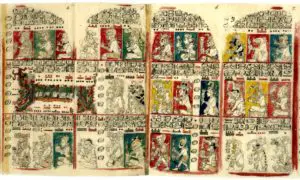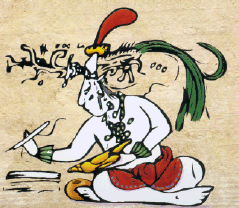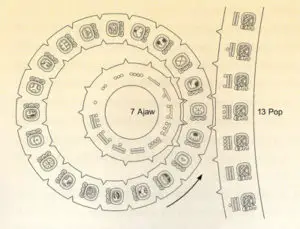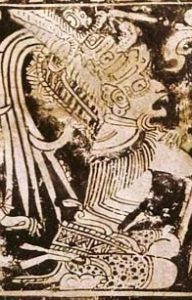Podcast: Play in new window | Download
Subscribe: Apple Podcasts | RSS
 In the Royal Library of Dresden, in the south-central part of newly formed German Empire, a 72-year-old man began writing down his insights about the colorful painted bark book before him. The year was 1894 and the man was Ernst Wilhelm Förstemann. Förstemann had been director of the Royal Library since 1865 and had a special affinity for what was called “The Mexican Book.” As a mathematician and historian, the director had begun to see patterns in this lime-covered, ancient, bark book. His insights were based on 14 years of “eureka” moments which had culminated in the first ever explanation of the calendar systems used by the ancient Maya. The bark book is known as the Dresden Codex, the oldest known manuscript from the Americas. The book, one of only a handful still in existence, was written by the ancient Mesoamerican scribes themselves and describes astronomical observations and ritual cycles. Parts of it also serve as an almanac. As the first person to crack the Maya calendar, Förstemann was also the first person to come up with an apocalyptic scenario tied to the calendar. He interpreted the last page of the Dresden Codex to be the end of the Maya calendar and destruction of the world, although he did not tie this in to the year 2012.
In the Royal Library of Dresden, in the south-central part of newly formed German Empire, a 72-year-old man began writing down his insights about the colorful painted bark book before him. The year was 1894 and the man was Ernst Wilhelm Förstemann. Förstemann had been director of the Royal Library since 1865 and had a special affinity for what was called “The Mexican Book.” As a mathematician and historian, the director had begun to see patterns in this lime-covered, ancient, bark book. His insights were based on 14 years of “eureka” moments which had culminated in the first ever explanation of the calendar systems used by the ancient Maya. The bark book is known as the Dresden Codex, the oldest known manuscript from the Americas. The book, one of only a handful still in existence, was written by the ancient Mesoamerican scribes themselves and describes astronomical observations and ritual cycles. Parts of it also serve as an almanac. As the first person to crack the Maya calendar, Förstemann was also the first person to come up with an apocalyptic scenario tied to the calendar. He interpreted the last page of the Dresden Codex to be the end of the Maya calendar and destruction of the world, although he did not tie this in to the year 2012.
A few decades after Förstemann came to understand the Maya calendar system, American archaeologist Sylvanus Morley added to what Förstemann was saying by writing that the Maya had predicted the end of the world in a great flood. Morley’s book, The Ancient Maya, first published in 1946, was the first time the general public heard anything about a “Maya Apocalypse.”
 Scholars began to decipher the writing system of the Maya in the mid-20th Century and with the reading of the glyphs came a better understanding of the world of the ancient Maya. Please see episode number sixteen of Mexico Unexplained, available at our website Mexico Unexplained dot com, for more information about the elaborate system of writing that the Maya developed in ancient times. Because dates were so important in their association with major events and the lives of the Maya elites, calendar references were everywhere in the Maya world. Archaeologists, epigraphers and other researchers came to a complete understanding of Maya calendrics by the 1950s.
Scholars began to decipher the writing system of the Maya in the mid-20th Century and with the reading of the glyphs came a better understanding of the world of the ancient Maya. Please see episode number sixteen of Mexico Unexplained, available at our website Mexico Unexplained dot com, for more information about the elaborate system of writing that the Maya developed in ancient times. Because dates were so important in their association with major events and the lives of the Maya elites, calendar references were everywhere in the Maya world. Archaeologists, epigraphers and other researchers came to a complete understanding of Maya calendrics by the 1950s.
So, where did the 2012 connection come in? Before we look at the connection to our own times, we need to go over a general explanation of what the Maya calendar system is and how it functions. The ancient Maya had two types of calendars. One, called the Calendar Round, combined Tzolkin, a period of 260 days, and intersected with the Haab’, a period roughly corresponding to the solar year. Imagine two wheels turning next to each other and touching one another at one point to produce a date. The  Calendar Round cycle repeated every 52 solar years. The Calendar Round primarily measures shorter periods of time. The Maya Long Count calendar was used independently of the Calendar Round to measure huge spans of time. The smallest measurement on this calendar was a k’in, or day. There were 8 other, much larger, measurements of time going from there. 1 winal equals 20 k’in, or 20 days, for example. One katun equals 7,200 days or approximately 20 years. The highest measure on the Maya Long Count Calendar was 1 alautun, which corresponded with 23.04 billion days or a little over 63 million years. Many people who have studied the Maya calendar have questioned the need for measuring time in such vast quantities. Please refer to the Long Count calendar table at mexico unexplained dot com in the show summary for this episode.
Calendar Round cycle repeated every 52 solar years. The Calendar Round primarily measures shorter periods of time. The Maya Long Count calendar was used independently of the Calendar Round to measure huge spans of time. The smallest measurement on this calendar was a k’in, or day. There were 8 other, much larger, measurements of time going from there. 1 winal equals 20 k’in, or 20 days, for example. One katun equals 7,200 days or approximately 20 years. The highest measure on the Maya Long Count Calendar was 1 alautun, which corresponded with 23.04 billion days or a little over 63 million years. Many people who have studied the Maya calendar have questioned the need for measuring time in such vast quantities. Please refer to the Long Count calendar table at mexico unexplained dot com in the show summary for this episode.
 While this was all being figured out, researchers realized that in the 20th Century we were nearing the end of one of the larger measured time periods of the calendar, the 13th baktun. Most Maya scholars agree that the 13th baktun began on August 11, 3114 BC. This is the mythical “beginning point” of the Maya. Researchers took a while to figure out the day on which the time period called the 13th baktun would end and even now some learned people in the field of Maya studies are unsure of the exact day. For example, Maud Worcester Makemson, a professor specializing in archaeoastronomy at Vassar, noted in her 1957 publication, “The miscellaneous dates of the Dresden Codex,” how important the end of the 13th baktun would be to the ancient Maya but using her complex methods used in decades of studying ancient astronomy Worcester Makemson came up with an exact date of June 13, 1752 for the ending of the 13th baktun cycle which is nowhere near the 2012 date. For the purposes of our own culture’s 2012 intersection with the Maya “end date,” respected Maya researcher Michael D. Coe came up with the date of December 24, 2011 in the first printing of his book The Maya in 1966. Not only did he come up with this date, he also stated “there is a suggestion that Armageddon would overtake the degenerate peoples of the world and all creation on the final day of the 13th baktun.” In 1980, in the 2nd edition of his book, Coe himself revised the date to January 11, 2013. Coe finally settled on the date of December 23, 2012 in the third edition of The Maya published in 1984. The first correlation we see in the popular literature to December 21, 2012 as the end of the Maya calendar cycle is found in a 1983 version of Sylvanus Morley’s 1946 book The Ancient Maya. Some believe that Coe’s date of Christmas Eve, 2012 was conveniently moved to the 21st so as to correspond to the winter solstice, thus making it more astronomically relevant, but we can never know for certain why there was a change made. We only know that it was repeated countless times as interest in the Maya Apocalypse grew.
While this was all being figured out, researchers realized that in the 20th Century we were nearing the end of one of the larger measured time periods of the calendar, the 13th baktun. Most Maya scholars agree that the 13th baktun began on August 11, 3114 BC. This is the mythical “beginning point” of the Maya. Researchers took a while to figure out the day on which the time period called the 13th baktun would end and even now some learned people in the field of Maya studies are unsure of the exact day. For example, Maud Worcester Makemson, a professor specializing in archaeoastronomy at Vassar, noted in her 1957 publication, “The miscellaneous dates of the Dresden Codex,” how important the end of the 13th baktun would be to the ancient Maya but using her complex methods used in decades of studying ancient astronomy Worcester Makemson came up with an exact date of June 13, 1752 for the ending of the 13th baktun cycle which is nowhere near the 2012 date. For the purposes of our own culture’s 2012 intersection with the Maya “end date,” respected Maya researcher Michael D. Coe came up with the date of December 24, 2011 in the first printing of his book The Maya in 1966. Not only did he come up with this date, he also stated “there is a suggestion that Armageddon would overtake the degenerate peoples of the world and all creation on the final day of the 13th baktun.” In 1980, in the 2nd edition of his book, Coe himself revised the date to January 11, 2013. Coe finally settled on the date of December 23, 2012 in the third edition of The Maya published in 1984. The first correlation we see in the popular literature to December 21, 2012 as the end of the Maya calendar cycle is found in a 1983 version of Sylvanus Morley’s 1946 book The Ancient Maya. Some believe that Coe’s date of Christmas Eve, 2012 was conveniently moved to the 21st so as to correspond to the winter solstice, thus making it more astronomically relevant, but we can never know for certain why there was a change made. We only know that it was repeated countless times as interest in the Maya Apocalypse grew.
In the late 1960s and early 1970s with the rise of the “Ancient Astronauts” phenomenon tied to lost civilizations, we see an increasing interest in the end of the 13th baktun. In books with names like The Outer Space Connection, pulp paperback authors conjectured that on the day of the end of the Maya calendar cycle the aliens would return to colonize earth. The Mesoamerican feathered serpent god Quetzalcoatl – called Kukulcán by the Maya – who had promised to return to ancient Mexico at some point in the future, was also linked to the 2012 phenomenon. Who, exactly, would be coming back in the form of the feathered serpent god? Many publications pondered this question.
 By the 1980s we saw the coming of the New Age Movement, a philosophy that looked for spiritual meaning outside the traditional religious, philosophical and scientific beliefs of the West. “Mayanism” became popular at this time. As defined by Wikipedia, Mayanism is “a non-codified eclectic collection of New Age beliefs, influenced in part by Pre-Columbian Maya mythology and some folk beliefs of the modern Maya peoples. Adherents of this belief system are not to be confused with Mayanists, scholars who research the historical Maya civilization.” The Maya were seen as a peaceful people comprised of astronomer priests who were either descended from extraterrestrials or who had contact with them. Because the New Age movement is a kind of philosophical globalism and draws from many cultures across the world, past and present, it sought to validate the 2012 apocalypse by tying it in with other belief systems which some critics would claim as a form of cherry-picking. Thus the so-called Maya end date became tied to such disparate works and ideas as the I Ching, the prophecies of the Hopi Indians and the legend of Atlantis.
By the 1980s we saw the coming of the New Age Movement, a philosophy that looked for spiritual meaning outside the traditional religious, philosophical and scientific beliefs of the West. “Mayanism” became popular at this time. As defined by Wikipedia, Mayanism is “a non-codified eclectic collection of New Age beliefs, influenced in part by Pre-Columbian Maya mythology and some folk beliefs of the modern Maya peoples. Adherents of this belief system are not to be confused with Mayanists, scholars who research the historical Maya civilization.” The Maya were seen as a peaceful people comprised of astronomer priests who were either descended from extraterrestrials or who had contact with them. Because the New Age movement is a kind of philosophical globalism and draws from many cultures across the world, past and present, it sought to validate the 2012 apocalypse by tying it in with other belief systems which some critics would claim as a form of cherry-picking. Thus the so-called Maya end date became tied to such disparate works and ideas as the I Ching, the prophecies of the Hopi Indians and the legend of Atlantis.
During the 1980s many argued that the end of the Maya baktun cycle was not representative of the physical end of the world, rather, it marked an upcoming shift in human consciousness. The 25-year countdown to the end of the current baktun officially began in August of 1987 with the Harmonic Convergence, the world’s first synchronized meditation event. The chief promoter of the event was José Argüelles who released the book The Mayan Factor: Path Beyond Technology to coincide with the event. The idea of something big happening on December 21, 2012 was now taken out of the New Age context and propelled into the mainstream as many people not connected with the Harmonic Convergence or the New Age Movement became curious about the Maya calendar and its implications.
 The 1980s and 1990s saw the tying in of the end of the Maya baktun cycle with astronomical events. In the 2012 literature we start seeing the mentioning of the “galactic alignment.” According to John Major Jenkins in his 1998 book, Maya Cosmogenesis 2012: The True Meaning of the Maya Calendar End-Date, “The Galactic Alignment is the alignment of the December solstice sun with the Galactic equator. This alignment occurs as a result of the precession of the equinoxes. Precession is caused by the earth wobbling very slowly on its axis and shifts the position of the equinoxes and solstices one degree every 71.5 years. Because the sun is one-half of a degree wide, it will take the December solstice sun 36 years to precess through the Galactic equator.” This galactic alignment coincidentally occurred on December 21, 2012 and the adherents to the belief in this astronomical theory claim that the baktun cycle ended on that day because the Maya predicted it. This alignment was not associated with any sort of planet-wide catastrophe, but some people believed that in addition to being aligned with the galactic center, the sun would also be aligned with a supermassive black hole located in the center of the galaxy called Sagittarius A. This alignment would cause destruction on a global scale. Others tying the end of the baktun cycle to astronomical events also claimed December 21, 2012 would see the return of Planet X – also called Niburu – as per the old Mesopotamian legends, that the red giant star Betelgeuse would go super nova and that the main star in the Pleiades would emit a series of photons that would form a belt around earth thus altering life as we know it.
The 1980s and 1990s saw the tying in of the end of the Maya baktun cycle with astronomical events. In the 2012 literature we start seeing the mentioning of the “galactic alignment.” According to John Major Jenkins in his 1998 book, Maya Cosmogenesis 2012: The True Meaning of the Maya Calendar End-Date, “The Galactic Alignment is the alignment of the December solstice sun with the Galactic equator. This alignment occurs as a result of the precession of the equinoxes. Precession is caused by the earth wobbling very slowly on its axis and shifts the position of the equinoxes and solstices one degree every 71.5 years. Because the sun is one-half of a degree wide, it will take the December solstice sun 36 years to precess through the Galactic equator.” This galactic alignment coincidentally occurred on December 21, 2012 and the adherents to the belief in this astronomical theory claim that the baktun cycle ended on that day because the Maya predicted it. This alignment was not associated with any sort of planet-wide catastrophe, but some people believed that in addition to being aligned with the galactic center, the sun would also be aligned with a supermassive black hole located in the center of the galaxy called Sagittarius A. This alignment would cause destruction on a global scale. Others tying the end of the baktun cycle to astronomical events also claimed December 21, 2012 would see the return of Planet X – also called Niburu – as per the old Mesopotamian legends, that the red giant star Betelgeuse would go super nova and that the main star in the Pleiades would emit a series of photons that would form a belt around earth thus altering life as we know it.
As the year 2012 came closer, books and disaster movies of impending catastrophe ramped up. Preppers stocked up on the basics: non-perishable food, water and ammunition. By New Year’s Eve of 2012 most people in the United States had heard something about the end of the world being in 2012 but were unsure of the details. There was a measurable amount of hysteria in parts of the world, as earth ramped up for what was another doomsday. There were now hundreds of theories as to what was going to happen and why, and many interconnected and overlapping ideas. The whole 2012 phenomenon became a dizzying mess. There was a huge backlash from traditional Maya scholars as we got closer and closer to the fateful date. As already mentioned, even the archaeologists could not agree as to when the baktun cycle would end, so many were baffled as to what seemed to be an out-of-control apocalypse prophesy. As December 21, 2012 came and went, humanity sighed a collective sigh. While nothing physically noticeable happened on that date, many believe that something unseen did happen and we have yet to see the results of what started in motion on that day.
 We will conclude this presentation by returning to the jungles of ancient Mexico. Since the middle of the 20th Century when the Maya calendar was sorted out for the first time, there have been discoveries of the end of the baktun cycle written on Maya monuments. One is at the site of Tortuguero in the Mexican state of Tabasco. On a partially-defaced inscription there, a series of glyphs have been interpreted to mean that when the 13th baktun ends there will be a display of “investiture” of the god B’olon Yokte’ who has been associated with sacrifices to ends of cycles of years at other Maya sites. The other reference is found at the Guatemalan site of La Corona, in a series of inscriptions on a staircase, and compares the then-recent completion of 13 katuns with the future completion of the 13th baktun. To this day, these two references to 2012 are the only ones we have and they say nothing of prophesy or have anything to do with the end of the world. It is not surprising, though, because the Maya were not known for predicting future events or recording what they thought might happen in the future. It is no wonder that a civilization that was unable to predict its own demise was not able to predict the end of the world.
We will conclude this presentation by returning to the jungles of ancient Mexico. Since the middle of the 20th Century when the Maya calendar was sorted out for the first time, there have been discoveries of the end of the baktun cycle written on Maya monuments. One is at the site of Tortuguero in the Mexican state of Tabasco. On a partially-defaced inscription there, a series of glyphs have been interpreted to mean that when the 13th baktun ends there will be a display of “investiture” of the god B’olon Yokte’ who has been associated with sacrifices to ends of cycles of years at other Maya sites. The other reference is found at the Guatemalan site of La Corona, in a series of inscriptions on a staircase, and compares the then-recent completion of 13 katuns with the future completion of the 13th baktun. To this day, these two references to 2012 are the only ones we have and they say nothing of prophesy or have anything to do with the end of the world. It is not surprising, though, because the Maya were not known for predicting future events or recording what they thought might happen in the future. It is no wonder that a civilization that was unable to predict its own demise was not able to predict the end of the world.
TABLE OF LONG COUNT UNITS
1 k’in = 1 day
1 winal = 20 k’in = 20 days
1 tun = 18 winal = 360 days = 1 year (approx.)
1 katun = 20 tun = 7,200 days = 20 years
1 baktun = 20 katun = 144,000 days = 394 years
1 piktun = 20 baktun = 2,880,000 days = 7,885 years
1 kalabtun = 20 piktun = 57,600,000 days = 157,704 years
1 kinchiltun = 20 kalabtun = 1,152,000,000 days = 3,154,071 years
1 alautun = 20 kinchiltun = 23,040,000,000 days = 63,081,429 years
REFERENCES (Not a formal bibliography)
The Maya by Michael D. Coe
Maya Cosmogenesis 2012: The True Meaning of the Maya Calendar End-Date by John Major Jenkins
The Mayan Factor: Path Beyond Technology by José Argüelles
The Maya, the Aztecs and Their Predecessors by Muriel Porter Weaver
The Outer Space Connection by Alan Landsburg
The 2012 Story: The Myths, Fallacies, and Truth Behind the Most Intriguing Date in History by John Major Jenkins
“Miscellaneous Dates of the Dresden Codex” in Publications of the Vassar College Observatory by Maud Worcester Makemson

3 thoughts on “The 2012 Doomsday and the Maya Calendar”
The end of the longest count on the Maya’s calendar occurred on December 21, 2012. Exactly what “alignment” occurred is largely misunderstood.
The notion that the Earth, Sun and center of the Milky Way will finally be “aligned” and mark the end of a 63 million year grand cycle may be true, but it fails to capture HOW or WHY this alignment occurs.
I admit I used to parrot this alignment too. That is until I discovered one of the deeper lessons Cydonia was trying to teach me. It turns out Cydonia also tracks the same grand cycle the Maya were tracking.
Allow me to explain.
What makes Mars so unique is its “obliquity”. Obliquity is simply a planet’s range of tilt relative to our solar systems ecliptic plane (the plane upon which all of the planets revolve around the Sun).
Earth has a very limited obliquity. It is currently tilted at 23.5 degrees and will shift back and forth between 22.1 and 24.5 degrees every 41,000 years.
Mars, on the other hand, has much larger range of tilt over a much greater amount of time. Mars is currently tilted at 25.2 degrees and will shift back and forth between 39 and 11 degrees every 80,000 years.
So what heavenly cycle could possibly be in play to account for MILLIONS of years? One of my ‘eureka’ moments was realizing that the symbolism and geometry of Cydonia was screaming for me to insert one last piece of the puzzle… that our entire solar system also has obliquity as it makes its way around our gigantic Milky Way.
Cydonia tracks this obliquity. The geometry and symbolism takes us back 65 million years to a time when this relationship was at 33.3 degrees and seems to resolve precisely now. What’s so significant about December 21, 2012 is not that the Earth, Sun and galactic center will be aligned; it’s that our solar system’s ecliptic plane, relative to the Milky Way’s equator, will cross the very critical and relevant 60 degree threshold.
But what’s the big deal?
Part of the lesson Cydonia teaches is that the geometric relationships of the heavens impact our collective consciousness. Certain relationships influence us in a positive way while others influence us in a negative way.
If I’m right, 60 degrees allows for the most “information flow”. Now is the time we can finally shed the endless cycles of rise and fall of our civilizations and RE-discover our full potential as a full-fledged, super high-tech, space faring civilization.
To understand why Cydonia takes us back 65 million years to 33.3 degrees and what’s so significant about that… read my book, The Crux of Cydonia; Truth, Light, & The Face on Mars, here: http://www.maxtheknife.com
stop cultural appropriating please. thanks.
What do you mean by this request/comment? Could you please explain?